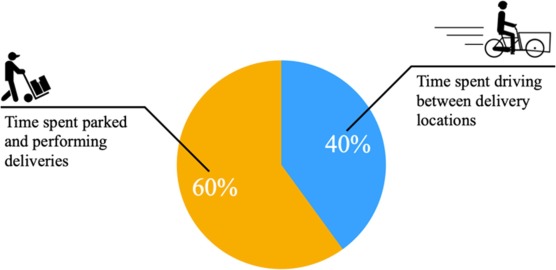Electric cargo cycles are often considered a viable alternative mode for delivering goods in an urban area. However, cities in the U.S. struggle to regulate cargo cycles, with most authorities applying the same rules for motorized vehicles or traditional bikes. One reason is the lack of understanding of the relationship between existing regulations, transport infrastructure, and cargo cycle parking and driving behaviors.
In a new study, researchers from the Department of Civil and Environmental Engineering, University of Washington, Seattle, analyzed a cargo cycle pilot test in Seattle and collected detailed data on the types of infrastructure used for driving and parking. GPS data were augmented by installing a video camera on the cargo cycle and recording the types of infrastructure used (distinguishing between the travel lane, bicycle lane, and sidewalk), the time spent on each type, and the activity performed.
The analysis created a first-of-its-kind, detailed profile of a cargo cycle driver’s parking and driving behaviors. We observed a strong preference for parking (80 percent of the time) and driving (37 percent of the time) on the sidewalk. We also observed that cargo cycle parking was generally short (about 4 min), and the driver parked very close to the delivery address (30 m on average) and made only one delivery. Using a random utility model, we identified the infrastructure design parameters that incentivize drivers not to use the sidewalk and to drive more on travel and bicycle lanes. The results from this study can be used to better plan for a future in which cargo cycles may be used to make deliveries in urban areas.
Some operational advantages of cargo bikes seem tied to their ability to use alternative infrastructure other than travel lanes for driving and curb lanes for parking, such as riding on sidewalks and counterflow. This allows the bike driver (as shown in this study) to park closer to the delivery destination, reduce walking distances, and serve just one or a few customers per stop, thus making more stops in a tour and shortening parking dwell times. Moreover, we also showed that cargo bikes do not cruise for parking and can park at the curb or on the sidewalk according to need and current curb availability.
However, some of these parking and driving behaviors, especially related to driving and parking on sidewalks, could potentially lead to safety concerns and other externalities for pedestrians, bikers, and other road users. This has led cities like New York to prohibit sidewalk usage by cargo bikes. However, prohibiting sidewalk usage without offering a suitable alternative infrastructure for cargo bike driving and parking might reduce cargo bike operational advantages over vans and trucks and shift the problems elsewhere, for instance, by clogging the bike infrastructure or creating more curb parking congestion.

Professor Jan Fransoo reacted on Linkedin to the result in Seatle: “apart from the extensive usage of sidewalk space usage, my interpretation is that this should have a substantial negative impact on the financial business case of using cargo bikes vs. using delivery vans. Much of the argument, having been made until now, is that the stop time per drop should be much lower for cargo bikes than for delivery vans. The data in this study shows this not to be the case”. Recent studies from Budapest and Germany show that the positive business case for cargo bikes in city logistics is ‘complicated.’
